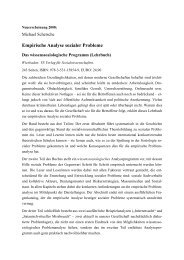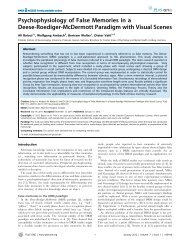2 Projects and Results - IGPP
2 Projects and Results - IGPP
2 Projects and Results - IGPP
Create successful ePaper yourself
Turn your PDF publications into a flip-book with our unique Google optimized e-Paper software.
Theorie und Datenanalyse 5<br />
most stable in the sense that only very special changes lead<br />
to improvement, while for other networks there are many<br />
changes in the structure which lead to an improvement of<br />
their performance. This hypothesis is presently under investigation.<br />
Furthermore, we found that the deletion of individual<br />
lines or nodes typically leads only to a partial failure<br />
of pattern recognition.<br />
Filk; together with von Müller<br />
Publication: Filk, von Müller (2008)<br />
Emergence of Small-World Properties<br />
A key question for learning networks is which structural<br />
properties distinguish networks performing optimally<br />
(“learners”) from r<strong>and</strong>om networks. In this context, we<br />
concentrated on small-world properties of networks, in particular<br />
on a generalization of the cluster coefficient. As has<br />
been shown in the literature, the distribution of certain motifs<br />
(particular sub-networks, notably triangles) can be considered<br />
as such a generalization. Comparing the distribution<br />
of motifs in learners with those in r<strong>and</strong>om networks,<br />
we found that particular motifs occur significantly more often<br />
in learners than in r<strong>and</strong>om networks. Furthermore, we<br />
investigated the eigenvalue distribution of the corresponding<br />
adjacency matrices. First results exhibit clear differences<br />
between learners <strong>and</strong> r<strong>and</strong>om graphs – for instance,<br />
the third moment, which is related to the abundance of triangles,<br />
changes drastically. Other features of these eigenvalue<br />
distributions are under investigation.<br />
Atmanspacher, Filk; together with Scheingraber<br />
2.1.5 Conceptual <strong>and</strong> Methodological Issues<br />
Concepts of Neuroscientific Research<br />
The dynamics of neuronal systems, briefly neurodynamics,<br />
has developed into an attractive <strong>and</strong> influential research<br />
branch within neuroscience. We identified <strong>and</strong> studied a<br />
number of conceptual issues in neurodynamics that are important<br />
for an appropriate interpretation <strong>and</strong> evaluation of<br />
its results. We demonstrated their relevance for selected<br />
topics of theoretical <strong>and</strong> empirical work. In particular, these<br />
are the notions of determinacy <strong>and</strong> stochasticity in neurodynamics<br />
across levels of microscopic, mesoscopic <strong>and</strong><br />
macroscopic descriptions. The issue of correlations between<br />
neural, mental <strong>and</strong> behavioral states was also addressed<br />
in some detail. An informed discussion of conceptual<br />
foundations with respect to neurobiological results will<br />
be crucial for a viable future philosophy of neuroscience.<br />
Atmanspacher, Rotter<br />
Publication: Atmanspacher, Rotter (2008)<br />
Research Between Anomaly <strong>and</strong> Orthodoxy<br />
Scientific research takes place in the field of tension between<br />
accepted coherent knowledge <strong>and</strong> not understood,<br />
not integrated fragments: between orthodoxy <strong>and</strong> anomaly.<br />
Orthodox knowledge is characterized by laws <strong>and</strong> norms<br />
which can be conceived formally (deterministic or statistical<br />
laws), methodologically (criteria for scientific work),<br />
or conceptually (frameworks of thinking, regulative principles).<br />
We proposed to classify anomalies according to<br />
their feasibility of being systematically connected with accepted<br />
knowledge. In this way, one can distinguish anomalies<br />
at the frontier of our knowledge, interior anomalies surrounded<br />
by accepted knowledge, <strong>and</strong> anomalies in no man’s<br />
l<strong>and</strong>. Examples have been discussed which show essential<br />
characteristics of each of these groups. Anomalies are the<br />
salt in the soup of science <strong>and</strong> dissolve where the domain<br />
of accepted knowledge extends or deepens – either by being<br />
elucidated or by being abolished.<br />
Atmanspacher<br />
Publications: Atmanspacher (2009b), Atmanspacher<br />
(2009e)<br />
Adaptive Analysis of Time Series<br />
Statistically significant effects in the analysis of time series<br />
usually rely on a large number of single tests sensitive<br />
to local deviations in time, spatial position, frequency, experimental<br />
condition, etc. Depending on the size of the<br />
search space, the desired resolution, <strong>and</strong> the available a<br />
priori knowledge, the required number of single tests can<br />
be huge. Unknown stochastic dependencies between the<br />
test statistics presents another difficulty to control the alpha<br />
error. Often these problems are circumvented by defining<br />
regions of interest or ab<strong>and</strong>oning finer resolution. We<br />
proposed a novel multiple testing procedure (“conquer <strong>and</strong><br />
divide”, CAD) based on an adaptive subdivision of the<br />
time domain. CAD starts at a coarse resolution level <strong>and</strong><br />
zooms in only where effects are distinctive. Monte Carlo<br />
simulations demonstrated CAD to be efficient in regard to<br />
both specifity <strong>and</strong> sensitivity. For extensions to arbitrary<br />
search trees exact control of the family-wise error probability<br />
could be established.<br />
Ehm, Kornmeier; together with Bach, Heinrich; funded by<br />
DFG<br />
Phase Synchronization<br />
Power analyses of EEG time series provide information<br />
about the collective behavior of spatially confined neuronal<br />
assemblies close to electrode positions. The integration of<br />
spatially <strong>and</strong> functionally separated brain areas, on the other<br />
h<strong>and</strong>, is supposed to be accomplished by a global synchronization<br />
of distant assemblies, with certain frequency b<strong>and</strong>s<br />
playing specific roles. Detecting such synchrony requires<br />
extracting time- <strong>and</strong> frequency-resolved phase information<br />
from parallel recorded EEG time series <strong>and</strong> quantifying the<br />
coherence between groups of corresponding phase courses.<br />
To avoid phase enslaving <strong>and</strong> spurious synchrony due to<br />
narrow b<strong>and</strong> filtering, we proposed a modification of the<br />
common “phase locking value” measure which adaptively<br />
damps down the influence of epochs where power is low.<br />
First results promise the new measure to be reliable <strong>and</strong><br />
robust, <strong>and</strong> superior to wavelet coherence. After some experimentation<br />
with the choice of the tuning parameters, the<br />
procedure will be utilized to study phase synchronization in<br />
connection with the perception of ambiguous visual stimuli.<br />
Ehm, Kornmeier; funded by the DFG<br />
Publication: Ehm, Kornmeier (2009)


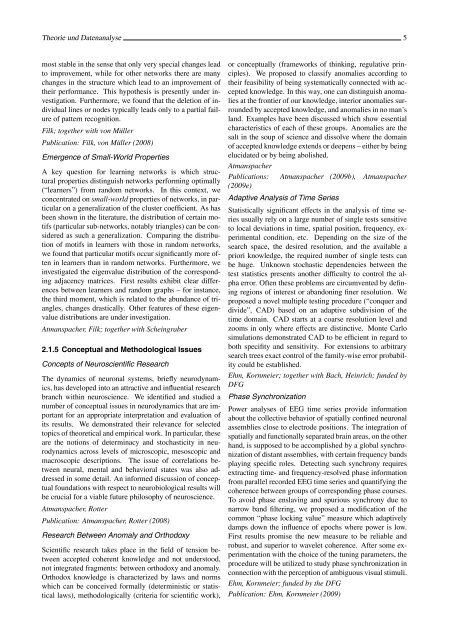
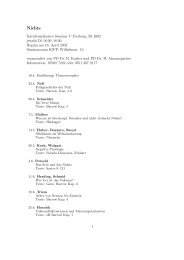

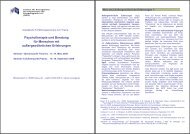
![Findliste Nachträge1 [pdf] - IGPP](https://img.yumpu.com/22552359/1/184x260/findliste-nachtrage1-pdf-igpp.jpg?quality=85)

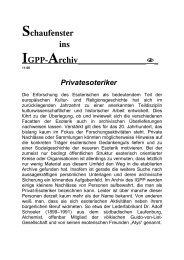
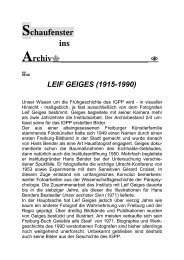
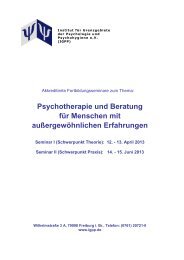
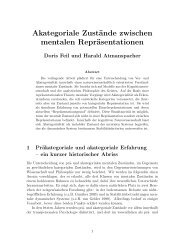
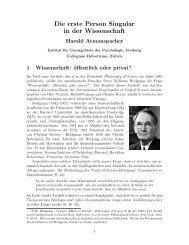
![Findliste [pdf] - IGPP](https://img.yumpu.com/22552265/1/190x245/findliste-pdf-igpp.jpg?quality=85)

